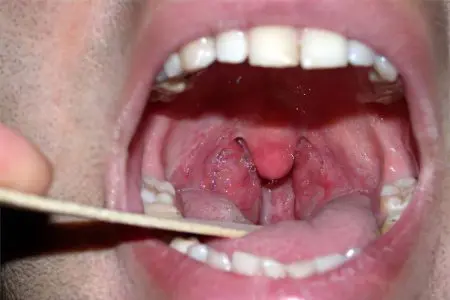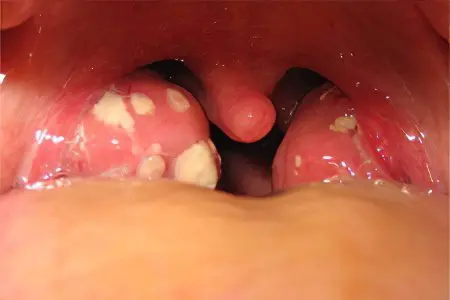Contents

Acute tonsillitis is an infectious and inflammatory disease accompanied by lesions of the palatine and / or pharyngeal tonsils with involvement of the lymphadenoid pharyngeal ring in the pathological process. Tonsillitis can act as an independent nosological form, or be a consequence (or manifestation) of infectious or somatic diseases. Most often, tonsillitis is provoked by streptococci.
In adults, during acute tonsillitis, in the vast majority of cases, the palatine tonsils become inflamed, and in children, the pharyngeal tonsils. Acute tonsillitis is diagnosed least often in the age group of children under 3 years of age and the elderly over 50 years of age. This is due to the fact that in babies, the tissue of the tonsils is still underdeveloped. In addition, babies under the age of 3 are much less likely to encounter pathogenic flora than children attending educational institutions. In older people, on the contrary, the lymphoid tissue of the tonsils gradually begins to involute.
Residents of large cities suffer from acute tonsillitis more often, as they spend more time in crowded places. The disease does not have a clear seasonality, however, it is more often recorded during epidemics of influenza and other acute respiratory viral infections. Acute tonsillitis is often combined with acute pharyngitis, in which the back wall of the pharynx becomes inflamed.
Forms of acute tonsillitis

It is customary to distinguish between several forms of acute tonsillitis:
Catarrh, in which the mucous membrane of the tonsils will be affected.
Lacunar inflammation, when tonsil lacunae are involved in the pathological process. Lacunae are deep channels in the tonsils that have a tortuous shape. Normally, they are independently cleansed of microbes, but as a result of a decrease in local immunity, lacunae lose their ability to self-cleanse. They accumulate plaque and purulent masses.
Follicular inflammation, when the disease captures the lymphoid follicles.
Fibrous tonsillitis.
Phlegmonous acute tonsillitis.
Ulcerative necrotic acute tonsillitis.
Mixed form of the disease.
If we consider acute tonsillitis, depending on the type of pathogen, then there are such forms of it:
Streptococcal is the most common form of the disease;
scarlet fever;
diphtheria;
Tularemia;
Syphilitic;
candidal;
tuberculosis, etc.
Causes of acute tonsillitis

The most common causative agent of acute tonsillitis is group A beta-hemolytic streptococcus, which is sown in patients in more than 50% of cases. Other pathogenic microorganisms that can cause inflammation of the tonsils: streptococci of other groups, Staphylococcus aureus, Haemophilus influenzae, Enterobacter.
Sometimes bacteria enter the tonsils from the outside, and sometimes it happens that a person activates his own conditionally pathogenic flora, which is normally restrained by the body’s immune forces, but is always present in it.
Risk factors for developing acute tonsillitis are:
General and local hypothermia.
Decreased body defenses.
Hypovitaminosis.
Problems with nasal breathing.
Dry air.
Recent acute respiratory viral infections.
Any factor that reduces the local and general immunity of a person can lead to the development of tonsillitis.
As for infection with harmful bacteria that cause tonsillitis from the external environment, they are most often transmitted by airborne droplets.
Symptoms of acute tonsillitis

It is impossible not to notice the symptoms of acute tonsillitis.
The clinical picture of developing inflammation is as follows:
Sore throat, which has a sharp character. They are enhanced when a person makes swallowing movements.
Swelling and redness of the tonsils.
The presence of purulent contents in the channels of lacunae.
The presence of plaque on the tonsils.
Inflamed tonsil follicles.
Enlargement and soreness of the cervical lymph nodes.
Increased weakness, general malaise.
An increase in body temperature up to 39-40 ° C.
Pain in muscles and joints, chills.
If the tubopharyngeal ridges are involved in the process of inflammation, then the pain during swallowing will be given to the ears.
In a severe course of the disease, a person has a pronounced intoxication of the body, persistent fever, which is practically impossible to eliminate with the help of antipyretics. Perhaps impaired consciousness, nausea and vomiting, abdominal pain.
Complications of acute tonsillitis

Complications of acute tonsillitis are divided into early and late.
The first of these include:
Otitis;
Lymphadenitis;
Sinusitis;
Inflammation of the lymph nodes;
Paratonsillitis;
Paratonsillar abscess.
These complications occur during illness and most often capture organs and tissues located in close proximity to the focus of inflammation.
Late complications of tonsillitis include:
Glomerulonephritis;
Rheumatism;
Rheumatic heart disease.
These complications develop several weeks after the onset of the disease. They are provoked by the spread of bacteria to distant organs through the bloodstream.
Diagnosis of acute tonsillitis

Diagnosis of tonsillitis is carried out by a local doctor or an ENT doctor. The diagnosis is made on the basis of the symptoms of the disease and pharyngoscopy.
Bacteriological examination of the mucous discharge from the tonsils is an extremely desirable diagnostic procedure. It allows you to determine the type of bacteria that provoked inflammation. It is also necessary to conduct a clinical blood test, which gives general information about the patient’s condition.
Differential diagnosis of acute tonsillitis should be carried out with diseases that have similar symptoms. First of all, it is infectious mononucleosis and enterovirus infection.
Treatment
If the patient feels satisfactory, then the treatment of acute tonsillitis is carried out at home. With severe intoxication, the patient is hospitalized in the infectious diseases department of the hospital.
For the first 3-4 days, bed rest should be adhered to so that the body has enough strength to recover.
It is necessary to follow a diet, with an emphasis on dairy products and plant foods. All dishes until the inflammation subsides should be served to the patient in a liquid or puree form. The temperature of the dishes matters: they should not be hot and not cold. It is important to consume fresh fruits and vegetables rich in vitamins. A prerequisite for a speedy recovery is drinking plenty of water.
An antibiotic should be prescribed by a doctor, based on bacterial culture of the mucus.
Basic principles for prescribing antibacterial drugs for acute tonsillitis:
Treatment should be course and last at least 10 days.
The sooner antibiotic therapy is started, the faster recovery will be achieved and the lower the risk of complications in the patient.
Family members of a patient with acute tonsillitis do not need prophylactic antibiotic therapy.
The drugs of choice for acute tonsillitis are unprotected penicillins. These drugs have high activity against streptococci, are well tolerated by patients and do not require high doses. Moreover, they have minimal impact on the human digestive system.
If a patient is diagnosed with recurrent acute tonsillitis, then the appointment of unprotected penicillins will be unjustified. The recurrence of inflammation indicates the persistence of bacteria and their release of the enzyme beta-lactamase. In this case, the group of protected penicillins will be the choice.
If the patient receives adequate treatment, then recovery occurs in 7-10 days.
When, after 2-3 days from the start of treatment, there are no signs of improvement in well-being, this indicates that the antibacterial drug was chosen incorrectly and its replacement is required. This may be a drug with a broader spectrum of action, or a protected penicillin (subject to treatment with unprotected penicillins).
At the time of treatment, smoking cessation is a prerequisite.
It is also possible to carry out the following auxiliary activities:
Gargling with antiseptic solutions.
Reception of warm foot baths, provided there is no temperature.
Carrying out inhalations with saline or alkaline mineral water.
Mechanical removal of plaque from the tonsils and “rubbing” them with drugs is an unacceptable measure in the treatment of tonsillitis. These manipulations can lead to trauma to the mucous membrane of the tonsils and aggravate the patient’s condition. Therefore, local treatment is reduced to the resorption of tablets with an antiseptic effect, irrigation of the tonsils with aerosols and sprays.
Operative treatment. The tonsils are part of the immune system and perform an important defense function in the body. Therefore, they are removed only as a last resort.
Indications for surgery may include:
Failure of conservative therapy.
Recurrent tonsillitis, having a severe course and recurring 3 or more times a year.
Complications from other organs.
Formation of paratonsillar abscess.
The operation is performed under general anesthesia and lasts an average of half an hour.
Prevention
To minimize the risk of developing inflammation of the tonsils, the following preventive measures must be observed:
Compliance with oral hygiene, timely treatment of caries.
Maintaining cleanliness in the room, frequent wet cleaning of the room, providing access to fresh air.
Timely and high-quality treatment of all diseases of the respiratory system.
Leading a healthy lifestyle, balanced diet.
Taking immunostimulating drugs during outbreaks of infectious and viral diseases.
Limit contact with people suffering from tonsillitis.
Forecast
The prognosis for acute tonsillitis primarily depends on the state of the patient’s immune system, as well as on how timely therapy is started. Properly conducted treatment leads to complete recovery of the patient and the absence of relapses of tonsillitis. Complications develop more often in those people who delay contacting a specialist and self-medicate.









